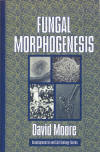12.16 Basic principles of fungal developmental biology
The main features of fungal developmental biology have been summarised as a set of principles by Moore (2005). The list (below) combines most of the observations made in the pregenomics era discussed above. It starts with the reminder that in many fungi hyphae differentiate from the vegetative form that ordinarily composes a mycelium and aggregate to form tissues of multihyphal structures; which may be linear organs that emphasise parallel arrangements of hyphae, or globose masses that emphasise interweaving of hyphae, such as sclerotia and fruit of the larger Ascomycota and Basidiomycota. The series of principles on which fungal morphogenesis is suggested to depend, most of which differ from both animals and plants, are as follows:
- Principle 1: the fundamental cell biology of fungi on which development depends is that hyphae extend only at their apex, and cross walls form only at right angles to the long axis of the hypha.
- Principle 2: fungal morphogenesis depends on the placement of hyphal branches. Increasing the number of growing tips by hyphal branching is the equivalent of cell proliferation in animals and plants. To proliferate, the hypha must branch, and to form an organised tissue the position of branch emergence and its direction of growth must be controlled.
- Principle 3: the molecular biology of the management of cell-to-cell interactions in fungi is completely different from that found in animals and plants; comprehensive genome surveys found no evidence in fungal genomes sequences which are crucial animal regulators, nor of plant control sequences.
- Principle 4: fungal morphogenetic programmes are organised into developmental subroutines, which are integrated collections of genetic information that contribute to individual isolated features of the programme. Execution of all the developmental subroutines at the right time and in the right place results in a normal structure. Developmental subroutines are equivalent to the transcriptional clusters, transcriptional waves of differential gene expression and differentially expressed gene sets detected in the transcriptional programme of the genome.
- Principle 5: because hyphae grow only at their apex, global change to tropic reactions of all the hyphal tips in a structure is sufficient to generate basic fruit body shapes.
- Principle 6: over localised spatial scales co-ordination is achieved by an inducer hypha regulating the behaviour of a surrounding knot of hyphae and/or branches. These are called hyphal knots and they have two fates, becoming either sclerotia or fruit body initials depending on temperature and illumination (high temperature and darkness favour sclerotia; light and lowered temperature favour the fruit body pathway).
- Principle 7: the response of tissues to tropic signals and the response of hyphal knots to their inducer hyphae, coupled with the absence of lateral contacts between fungal hyphae analogous to the plasmodesmata, gap junctions and cell processes that interconnect neighbouring cells in plant and animal tissues suggest that development in fungi is regulated by morphogens communicated mainly through the extracellular environment. Up-regulation of genomic transcripts in the ‘extracellular matrix’ category corresponds with what is known about the importance of the extracellular matrix to formation of hyphal knot which exude fluid droplets as they mature and become more condensed.
- Principle 8: fungi can show extremes of cell differentiation in adjacent hyphal compartments even when pores in the cross wall appear to be open (as judged by transmission electron microscopy).
- Principle 9: meiocytes appear to be the only hyphal cells that become committed to their developmental fate. Other highly differentiated cells retain totipotency - the ability to generate vegetative hyphal tips that grow out of the differentiated cell to re-establish a vegetative mycelium. Genomic analysis demonstrates that fungi, in general, have numerous genes involved in creating epigenetic marks by DNA methylation.
- Principle 10: in arriving at a morphogenetic structure and/or a state of differentiation, fungi are tolerant of considerable imprecision (= expression of fuzzy logic), which results in even the most abnormal fruit bodies (caused by errors in execution of the developmental subroutines) being still able to distribute viable spores, and poorly (or wrongly-) differentiated cells still serving a useful function.
- Principle 11: mechanical interactions influence the form and shape of the whole fruit body as it inflates and matures, and often generate the shape with which we are most familiar.
These Principles form the warp and weft of the canvas upon which fungal developmental biology has been built by the cell and molecular biologists of the pre-genomics era. It is now up to the genomic systems analysts to paint the rest of the individual details of the stories on that canvas (Kües & Navarro-González, 2015; Kües et al., 2018; Halbwachs et al., 2016; Pelkmans et al., 2016; Hibbett et al., 2017; Stajich, 2017).
| For the price of a Coffee & Coffee
Cake ($5) you can
buy yourself a PDF file of this chapter from 21st Century
Guidebook to Fungi Online. Our PDFs feature an elegantly simple text layout that is easily readable on your mobile or other device, and all hyperlinks are live so you can continue to enjoy your Internet experience. Chapter 12: Development and morphogenesis. The following appendix items are attached to this chapter: Don Emmeluth’s Latin and Greek Derivations; Ten ways to make a mushroom; and Genomic systems analysis of fungi starter references, making a 74-page PDF file priced at FIVE US$ ($5) Delivered to you by SendOwl Not convinced yet? Download a FREE sample HERE  |
|
This is still the only book available that deals with general fungal developmental biology.Ordering details: Fungal Morphogenesis, New York: Cambridge University Press. ISBN-13: 9780521552950. DOI: http://doi.org/10.1017/CBO9780511529887.
|
Updated July, 2019

